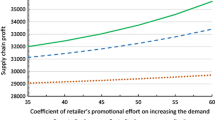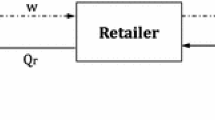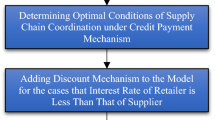Abstract
This study develops a coordination scheme based upon discount contract to coordinate promotional efforts and periodic review replenishment decisions. We consider a supplier-retailer chain with stochastic demand dependent on promotional efforts. The retailer uses a periodic review order-up-to-level inventory system and makes promotional efforts as a means of enhancing market demand. In traditional trading market, the retailer individually determines the replenishment and promotional efforts decisions based upon his/her own profitability. However, these decisions affect the sales volume of the whole system and consequently influence the supplier’s profitability. Therefore, it is worth devising a coordination plan that not only enhances the entire system’s profitability but also brings great benefits to both the retailer and the supplier. To this end, we first propose a decentralized model where each member’s profit function is optimized regardless of the others’ profitability. Then, a centralized model is investigated to achieve the best values of replenishment and promotional efforts decisions from the whole supply chain viewpoint. Afterwards, an incentive plan based upon a discount factor is developed to guarantee the members’ participation in the coordination plan. Upper and lower limits of the discount factor are derived based upon the members’ conditions for taking part in the plan. Moreover, we propose an industrial case study and a comprehensive sensitivity analysis. The outcomes of the model indicate that the proposed coordination scheme is effective and desirable even when the level of demand uncertainty increases.






Similar content being viewed by others
References
Aust G, Buscher U (2014) Cooperative advertising models in supply chain management: a review. Eur J Oper Res 234(1):1–14
Bai QG, Xu XH, Chen MY, Luo Q (2015) A two-echelon supply chain coordination for deteriorating item with a multi-variable continuous demand function. Int J Syst Sci Oper Logist 2(1):49–62
Bai Q, Xu X, Xu J, Wang D (2016) Coordinating a supply chain for deteriorating items with multi-factor-dependent demand over a finite planning horizon. Appl Math Model 40(21):9342–9361
Bischak DP, Robb DJ, Silver EA, Blackburn JD (2014) Analysis and management of periodic review, order-up-to level inventory systems with order crossover. Product Oper Manag 23(5):762–772
Cachon GP, Zipkin PH (1999) Competitive and cooperative inventory policies in a two-stage supply chain. Manag Sci 45(7):936–953
Chaab J, Barzoki MR (2016) Cooperative advertising and pricing in a manufacturer-retailer supply chain with a general demand function; a game-theoretic approach. Comput Ind Eng 99:112–123
Chaharsooghi SK, Heydari J (2010) Optimum coverage of uncertainties in a supply chain with an order size constraint. Int J Adv Manuf Technol 47(1–4):283–293
Chaharsooghi SK, Heydari J, Nakhai Kamalabadi I (2011) Simultaneous coordination of order quantity and reorder point in a two-stage supply chain. Comput Oper Res 38(12):1667–1677
Chen T (2011) Coordinating the ordering and advertising policies for a single-period commodity in a two-level supply chain. Comput Ind Eng 61(4):1268–1274
Consumer Electronics Promotional Review (2015) from Ad Dynamics website on the World Wide Web: https://addynamics.com/wp-content/uploads/sites/4/2015/09/AD360Series-Consumer-Electronics-Holiday-2014-Planning.pdf Accessed June 29, 2018
Dillon M, Oliveira F, Abbasi B (2017) A two-stage stochastic programming model for inventory management in the blood supply chain. Int J Prod Econ 187:27–41
Duan Y, Luo J, Huo J (2010) Buyer–vendor inventory coordination with quantity discount incentive for fixed lifetime product. Int J Product Econ 128(1):351–357
Giri BC, Sharma S (2014) Manufacturer’s pricing strategies in cooperative and non-cooperative advertising supply chain under retail competition. Int J Ind Eng Comput 5(3):473–494
Govindan K, Popiuc MN (2014) Reverse supply chain coordination by revenue sharing contract: a case for the personal computers industry. Eur J Oper Res 233(2):326–336
Goyal SK, Gupta YP (1989) Integrated inventory models: the buyer-vendor coordination. Eur J Oper Res 41(3):261–269
Gurnani H (2001) A study of quantity discount pricing models with different ordering structures: order coordination, order consolidation, and multi-tier ordering hierarchy. Int J Prod Econ 72(3):203–225
Gurnani H, Erkoc M, Luo Y (2007) Impact of product pricing and timing of investment decisions on supply chain co-opetition. Eur J Oper Res 180(1):228–248
He Y, Zhao X, Zhao L, He J (2009) Coordinating a supply chain with effort and price dependent stochastic demand. Appl Math Model 33(6):2777–2790
Heydari J (2014a) Lead time variation control using reliable shipment equipment: an incentive scheme for supply chain coordination. Transp Res E Logist Transp Rev 63:44–58
Heydari J (2014b) Supply chain coordination using time-based temporary price discounts. Comput Ind Eng 75:96–101
Heydari J (2015) Coordinating replenishment decisions in a two-stage supply chain by considering truckload limitation based on delay in payments. Int J Syst Sci 46(10):1897–1908
Heydari J, Norouzinasab Y (2015) A two-level discount model for coordinating a decentralized supply chain considering stochastic price-sensitive demand. J Ind Eng Int 11(4):531–542
Hosseini-Motlagh SM, Nematollahi M, Nouri M (2018a) Coordination of green quality and green warranty decisions in a two-echelon competitive supply chain with substitutable products. J Clean Prod 196:961–984
Hosseini-Motlagh SM, Nematollahi M, Johari M, Sarker BR (2018b) A collaborative model for coordination of monopolistic manufacturer’s promotional efforts and competing duopolistic retailers’ trade credits. Int J Prod Econ 204:108–122
Huang X, Choi SM, Ching WK, Siu TK, Huang M (2011) On supply chain coordination for false failure returns: a quantity discount contract approach. Int J Prod Econ 133(2):634–644
Johari M, Hosseini-Motlagh SM (2018) Coordination of cooperative promotion efforts with competing retailers in a manufacturer-retailer supply chain. Uncertain Supply Chain Manag 6(1):25–48
Johari M, Hosseini-Motlagh SM, Nematollahi M, Goh M, Ignatius J (2018) Bi-level credit period coordination for periodic review inventory system with price-credit dependent demand under time value of money. Transp Res E Logist Transp Rev 114:270–291
Karimi-Nasab M, Konstantaras I (2013) An inventory control model with stochastic review interval and special sale offer. Eur J Oper Res 227(1):81–87
Karray S, Surti C (2016) Channel coordination with quantity discounts and/or cooperative advertising. Int J Prod Res 7543:1–19
Kouki C, Jemai Z, Sahin E, Dallery Y (2014) Analysis of a periodic review inventory control system with perishables having random lifetime. Int J Prod Res 52(1):283–298
Li J, Liu L (2006) Supply chain coordination with quantity discount policy. Int J Prod Econ 101(1):89–98
Ma P, Wang H, Shang J (2013) Supply chain channel strategies with quality and marketing effort-dependent demand. Int J Prod Econ 144(2):572–581
Mukhopadhyay SK, Su X, Ghose S (2009) Motivating retail marketing effort: optimal contract design. Product Oper Manag 18(2):197–211
Nematollahi M, Hosseini-Motlagh SM, Heydari J (2017a) Economic and social collaborative decision-making on visit interval and service level in a two-echelon pharmaceutical supply chain. J Clean Prod 142:3956–3969
Nematollahi M, Hosseini-Motlagh SM, Heydari J (2017b) Coordination of social responsibility and order quantity in a two-echelon supply chain: a collaborative decision-making perspective. Int J Prod Econ 184:107–121
Nematollahi M, Hosseini-Motlagh SM, Ignatius J, Goh M, Nia MS (2018) Coordinating a socially responsible pharmaceutical supply chain under periodic review replenishment policies. J Clean Prod 172:2876–2891
Ouyang L, Chuang B (1999) A minimax distribution free procedure for periodic review inventory model involving variable lead time. Int J Inf Manag Sci 9:25–36
Panda S (2014) Coordination of a socially responsible supply chain using revenue sharing contract. Transp Res E Logist Transp Rev 67:92–104
Pu X, Gong L, Han G (2016) A feasible incentive contract between a manufacturer and his fairness-sensitive retailer engaged in strategic marketing efforts. J Intell Manuf 14:1–14
Roy A, Sana SS, Chaudhuri K (2016) Joint decision on EOQ and pricing strategy of a dual channel of mixed retail and e-tail comprising of single manufacturer and retailer under stochastic demand. Comput Ind Eng 102:423–434
Sana SS (2013) Optimal contract strategies for two stage supply chain. Econ Model 30(1):253–260
Sarathi GP, Sarmah SP, Jenamani M (2014) An integrated revenue sharing and quantity discounts contract for coordinating a supply chain dealing with short life-cycle products. Appl Math Model 38(15–16):4120–4136
Tsao YC, Sheen GJ (2012) Effects of promotion cost sharing policy with the sales learning curve on supply chain coordination. Comput Oper Res 39(8):1872–1878
Vijayan T, Kumaran M (2008) Inventory models with a mixture of backorders and lost sales under fuzzy cost. Eur J Oper Res 189:105–119
Weng ZK (1995) Channel coordination and quantity discounts. Manag Sci 41(9):1509–1522
Wu DD (2013) Bargaining in supply chain with price and promotional effort dependent demand. Math Comput Model 58(9–10):1659–1669
Xiao T, Xu T (2013) Coordinating price and service level decisions for a supply chain with deteriorating item under vendor managed inventory. Int J Prod Econ 145(2):743–752
Xie J, Wei JC (2009) Coordinating advertising and pricing in a manufacturer–retailer channel. Eur J Oper Res 197(2):785–791
Yang S, Liao Y, Shi CV, Li S (2015) Joint optimization of ordering and promotional strategies for retailers: rebates vs. EDLP. Comput Ind Eng 90:46–53
Yue J, Austin J, Wang MC, Huang Z (2006) Coordination of cooperative advertising in a two-level supply chain when manufacturer offers discount. Eur J Oper Res 168(1):65–85
Zegordi SH, Mokhlesian M (2015) Coordination of pricing and cooperative advertising for perishable products in a two-echelon supply chain: a bi-level programming approach. J Ind Syst Eng 8(4):39–60
Acknowledgements
The authors are grateful to the editor and two anonymous reviewers for their valuable comments, which have greatly improved this paper.
Author information
Authors and Affiliations
Corresponding author
Appendices
Appendix 1. Proving the concavity of the supplier’s profit function
To prove concavity of the retailer’s profit function over \(k\) and \(a\), it suffices to prove that the Hessian matrix represented below is negative definite.
where,
\(H_{11}\) is always less than zero over \(k\) and \(a\), for any T and \(H_{22}\) is always greater than zero. Thus, the Hessian matrix \(H\left( { {\text{TP}}_{\text{r}} \left( {{\text{T}},{\text{k}},{\text{a}}} \right)} \right)\) is proved to be negative definite and therefore the concavity of the retailer’s profit function over \(k\) and \(a\) is guaranteed.
Appendix 2. Proving the concavity of supplier’s profit function
To prove concavity of \(TP_{s} \left( n \right)\) over n, the second derivative of \(TP_{s} \left( n \right)\) with respect to n is calculated and is shown that it is negative.
(36) shows the first derivative of \(TP_{s} \left( n \right)\) with respect to n;
And (37) shows the second derivative of \(TP_{s} \left( n \right)\) with respect to n;
As can be seen, the second derivative of \({\text{TP}}_{\text{s}} \left( n \right)\) over n is always negative. Therefore, the supplier’s profit function is concave over \(n\).
Appendix 3. Proving the concavity of supply chain’s profit function
To prove concavity of \({\text{TP}}_{\text{sc}} \left( {{\text{T}},{\text{k}},{\text{a}},{\text{n}}} \right)\) with respect to \(k\), \(a\) and n simultaneously, it suffices to show that the Hessian matrix of \({\text{TP}}_{\text{sc}} \left( {{\text{T}},{\text{k}},{\text{a}},{\text{n}}} \right)\) represented by (38), is negative definite for any \(T\).
The Hessian matrix of \({\text{TP}}_{\text{sc}} \left( {{\text{T}},{\text{k}},{\text{a}},{\text{n}}} \right)\) for any \(T\) is:
where,
A Hessian matrix is called to be negative definite when \(k^{TH}\) principal minor of the matrix has the sign of \(\left( { - 1} \right)^{k}\). Thus, for the above matrix to be negative definite, the first minor (\(H_{11}\)), the second minor (\(H_{22}\)) and the third minor (\(H_{33}\)) must be negative, positive and negative, respectively. According to (39), \(H_{11}\) is always negative. (40) shows that \(H_{22}\) is positive when the condition represented by (10) is satisfied and (41) indicates that \(H_{33}\) will be negative, if the condition represented by (11) is satisfied.
Appendix 4. Proof of Theorem 2
Finding the upper limit on \(T\). under the centralized model.
Since \(\upphi_{z} \left( k \right)\). is the normal distribution function, it always satisfies \(\upphi_{z} \left( k \right) \ge 0\). Accordingly, the non-equality \(1 - \upphi_{z} \left( k \right) \le 1\). is always satisfied. Besides, Eq. (12) can be rewritten as \(1 - \upphi_{z} \left( {k^{**} } \right) = \frac{{Th_{r} }}{{h_{r} \alpha T + \left( {\alpha \left( {r - p} \right) + \pi - h_{s} \frac{{\alpha \left( {n - 1} \right)T}}{2}} \right)}}\). Due to the fact that \(1 - \upphi_{z} \left( {k^{**} } \right) \le 1\), we have \(\frac{{Th_{r} }}{{h_{r} \alpha T + \left( {\alpha \left( {r - p} \right) + \pi - h_{s} \frac{{\alpha \left( {n - 1} \right)T}}{2}} \right)}} \le 1\). Making some simplifications will result in the upper bound represented by (15).
Appendix 5. Proving the concavity of supply chain’s profit function under the simplified model
To prove the concavity of \({\text{TP}}_{\text{sc}} \left( {{\text{T}},{\text{k}},{\text{n}}} \right)\). with respect to \(k\). and n simultaneously, it suffices to show that the Hessian matrix of \({\text{TP}}_{\text{sc}} \left( {{\text{T}},{\text{k}},{\text{n}}} \right)\) represented by (42), is negativeefinite for any \(T\).
The Hessian matrix of \({\text{TP}}_{\text{sc}} \left( {{\text{T}},{\text{k}},{\text{n}}} \right)\) for any \(T\) is:
where,
for the above matrix to be negative definite, the first minor (\(H_{11}\)) and the second minor (\(H_{22}\)) must be negative and positive, respectively. According to (43), \(H_{11}\) is negative when the condition \(\left( {r - p} \right) + \pi + h_{r} \alpha T - h_{s} \frac{{\alpha \left( {n - 1} \right)T}}{2} > 0\) is satisfied. (44) shows that \(H_{22}\) is positive when the condition \(\frac{{2A_{s} \varphi_{z} \left( k \right)}}{{n^{3} T^{2} }}[ {\alpha \left( {r - p} \right) + \pi + h_{r} \alpha T - h_{s} \frac{{\alpha \left( {n - 1} \right)T}}{2}} ] > \sigma \left( {T + L} \right)^{{\frac{1}{2}}} ( {\frac{{h_{s} \alpha }}{2}\left( {1 - \varphi_{z} \left( k \right)} \right)} )^{2}\) is satisfied.
Rights and permissions
About this article
Cite this article
Nouri, M., Hosseini-Motlagh, SM. & Nematollahi, M. Proposing a discount policy for two-level supply chain coordination with periodic review replenishment and promotional efforts decisions. Oper Res Int J 21, 365–398 (2021). https://doi.org/10.1007/s12351-018-0434-x
Received:
Revised:
Accepted:
Published:
Issue Date:
DOI: https://doi.org/10.1007/s12351-018-0434-x




